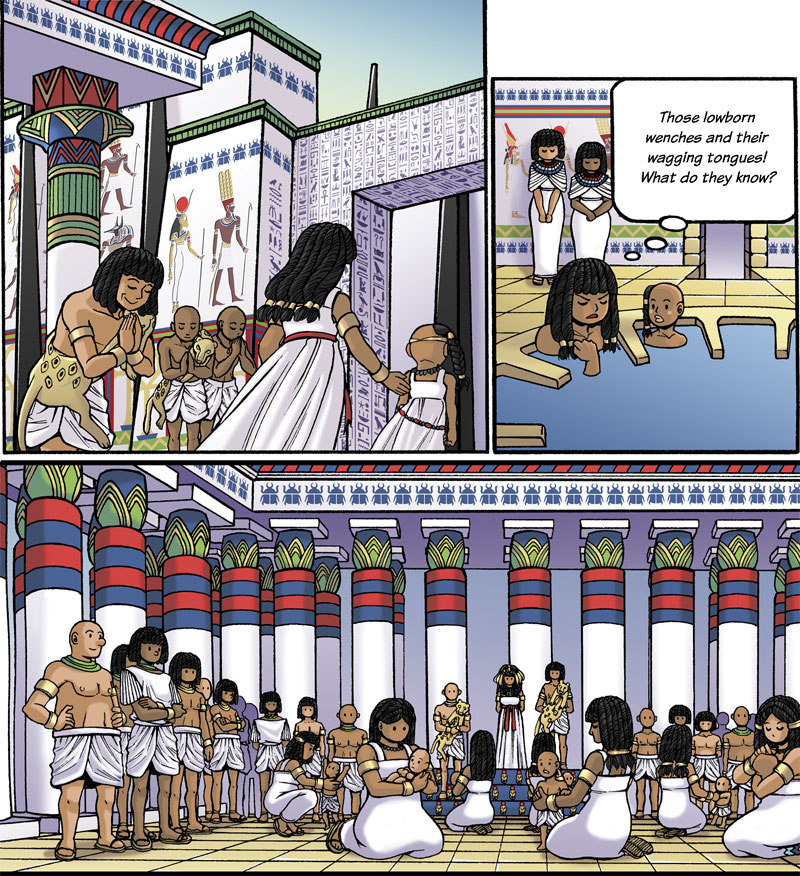The most important religious site of Hatshepsut’s day was probably Amun’s Temple of Karnak in Thebes, which was the centre of the cult of Amun that Hatshepsut was head priestess (God’s wife) of. Karnak was the centre of many large-scale building projects by many pharaohs, including the famous obelisks that Hatshepsut was known for raising, one of which still stands today. Luckily for us, Karnak has been reconstructed by digital means via the Digital Karnak project, so it’s fairly easy to get a good grasp of who build what and when.
- We actually don’t really know what was painted on much of Karnak’s walls, but it’s safe to assume that it was mostly of Egyptian gods and other such inscriptions. Parts of Karnak was always being demolished and rebuilt by successive pharaohs, so even the ruins of Karnak nowadays don’t necessarily much resemble what they looked like in Hatshepsut’s time.
- The panel in the top right hand corner depicts the purification baths Hatshepsut would have bathed in before she conducted her duties as God’s Wife of Amun. Unfortunately, they were based off roman-era (Ptolemic) baths that were built near Karnak some centuries later, recently discovered, meaning that Hatshepsut’s baths probably didn’t look like that. However, they were the only source material I could find of what the baths may have looked like.
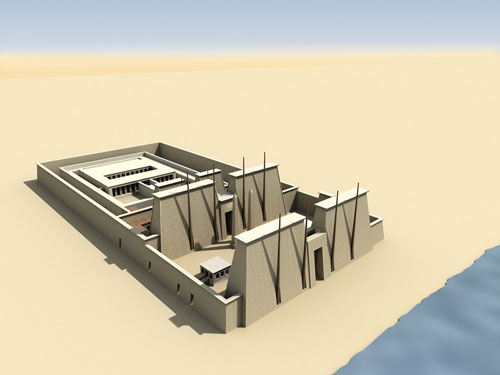
A computer-generated model of what Karnak might have looked like in Hatshepsut’s time. This is BEFORE she had built her first pair of obelisks. SOURCE: Digital Karnak
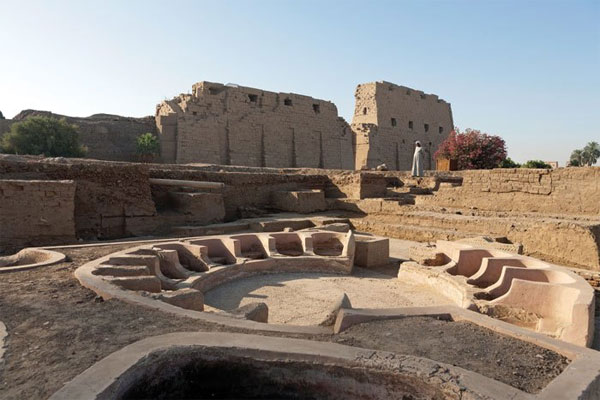
Roman-era baths uncovered near the temple of Luxor. SOURCE: World Archaeology
![]()
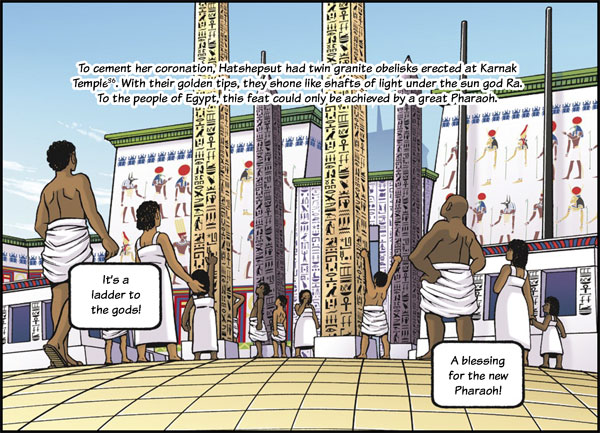
These are the first pair of obelisks Hatshepsut raised, which was commissioned during the reign of Thutmose II and located near the front gate of Karnak. Her obelisks were gold-plated and full of inscriptions, and you may notice a smaller, shorter pair of obelisks behind them. Those pair of obelisks were raised by her father Thutmose I, and while they were probably gold too, I decided to make their colour duller because otherwise there would appear to be four obelisks when the text clearly states there were two. Either way, there are still four obelisks in the picture; just understand that Hatshepsut raised the taller ones only. One of her obelisks still stands today.
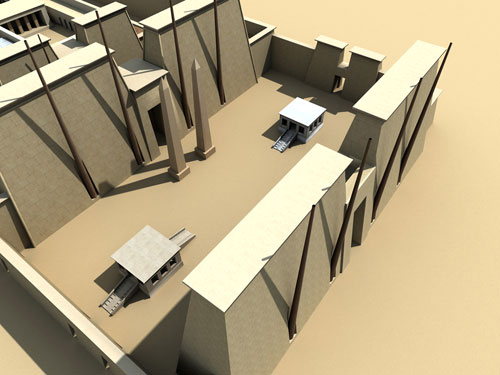
A clearer look at the front gate of Karnak, showing the twin obelisks of Thutmose I, but not those raised by Hatshepsut. Hatshepsut would raise her larger ones in front of her father’s. SOURCE: Digital Karnak
![]()

Hatshepsut built an untold number of temples to Egyptian gods and goddesses, and a few of them remain today in all their (faded) glory. She was one of the first pharaohs to build extensively in stone, which meant her buildings lasted a lot longer than those that came before her.
- Top left panel: Depicts a temple she dedicated to the lioness-headed goddess of war Pakhet, which the Greeks equated to their goddess of the hunt Artemis. It’s referred to nowadays by it’s Greek name Speos Artemeidos. Once again, I imagined it as brightly-painted in its heyday.
- Top middle panel: The red chapel, made of red granite, would have been a beautiful building had it been left standing. Sadly, it seemed that Hatshepsut never got got finish building it and Thutmose III possibly had to finish it for her, since the top level inscriptions were all inscribed with Thutmose III’s name. He later dismantled it completely to make way for his other building projects. It was originally built as a barque shrine, which is waystation for a god to rest in when his/her statue is being carried around on a barque, a ceremonial boat that the god “travels” in.
- Top right panel: Hatshepsut commissioned a number of sphinxes in her time, many as statues lining the way to Karnak’s entrances. Thutmose III would replace them with his own sphinxes, but you can still see some of Hatshepsut’s more feminine-looking sphinxes at the Metropolitan Museum of Art. Many people aren’t aware that sphinxes were brightly-painted in their time as well.
- Bottom panel: Hatshepsut’s mortuary temple of Djeser-Djeseru (‘Holiest of Holies), which is not her tomb, as it is dedicated to Amun. Her funerary cult didn’t last long after her death, but the temple was being used by various other religious cults for centuries after, until it became unsafe. The most important thing about this rendition of Djeser-Djeseru is that it includes another mortuary temple to its left, the mortuary temple of Mentuhotep II. This means that the structure you see with the pyramid is actually not part of Djeser-Djeseru, but it was already there when Djeser-Djeseru was built right next to it. Mentuhotep II’s temple didn’t survive the ages, which is why the real image of Djeser-Djsesru below doesn’t have it. A third temple to Amun was built by Thutmose III between and to the back of these two temples, but it also didn’t survive. Obviously, since the Thutsmose III-built structure didn’t exist during Hatshepsut’s lifetime it’s not depicted here.
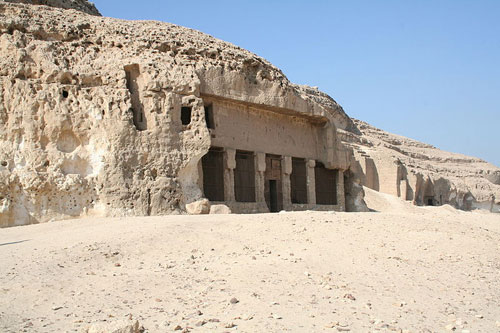
This temple dedicated to Pakhet, the lioness-headed goddess of war was also called Speos Artemidos (Grotto of Artemis) by the Greeks. SOURCE: Wikipedia
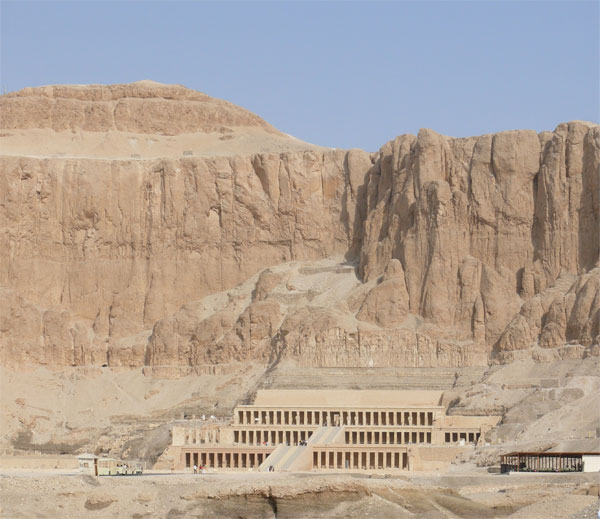
Hatshepsut’s most famous building, her mortuary temple of Djeser-Djeseru, which still stands today. SOURCE: Wikipedia
![]()

A rendition of Amun’s barque being carried by his priests. There weren’t many opportunities for the gods’ barques to make an appearance in this story, but nearly all gods had barques and followers who carried them around before the public in festivals.
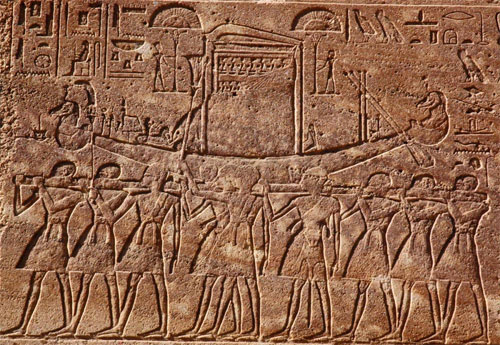
This is a relief from the Red Chapel of Amun’s barque being carried by his priests. The figurehead of the barque (on both prow and stern) are ram’s heads because they’re sacred to Amun.
![]()
Visual Sources
- Cooney, Kara. “The Woman Who Would be King: Hapshetsut’s Rise to Power in Ancient Egypt”. USA: Crown Publishers, 2014.
- Leser, Dr. Karl H. “Maat-Ka-Ra Hatshepsut”. Maat-Ka-Ra Hatshepsut. N.p., 6
Dec. 2013. Web. 1 Aug. 2017. http://www.maat-ka-ra.de/ - Sullivan, Elaine (Project Coordinator). “Digital Karnak: Time Map”. Digital Karnak.
UCLA, 2008. Web. 1 Aug. 2017. http://dlib.etc.ucla.edu/projects/Karnak/ - “Wonders of Egypt”. Current World Archaeology, Egypt, Issue 61, 27 Sep. 2013. Web. 30 Nov. 2017. https://www.world-archaeology.com/world/africa/egypt/wonders-of-egypt/
- “Sacred Barks and Divine Rest Stations”. The Karnak Great Hypostyle Hall Project. The University of Memphis, Date Unknown. Web. 30 Nov. 2017. http://www.memphis.edu/hypostyle/meaning_function/sacred-barks.php

